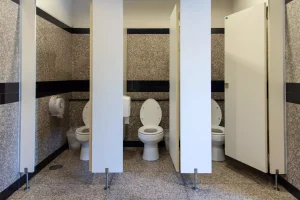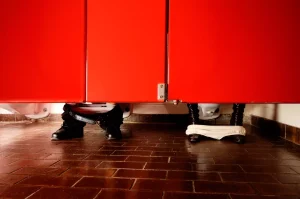There’s a compelling reason behind why public bathroom doors don’t touch the ground, a topic that has piqued the curiosity of many. Experts and design enthusiasts alike have uncovered a variety of explanations, ranging from hygiene to practical considerations. Social media, particularly TikTok, has become a platform for sharing these insights, making what might seem like a mundane design choice surprisingly interesting.

Understanding the Design Choices
In a viral TikTok video, content creator @mattypStories delves into why public restroom doors are designed with gaps at the bottom. He explains that most people have likely wondered about this design choice at some point, and the answers he provides are quite logical.
First and foremost, the design is practical. If an emergency were to occur—such as someone collapsing inside a stall—the gap allows others to see inside and provide help more easily. This feature enhances safety and can be crucial in urgent situations.
Another key reason for the gaps is cleaning efficiency. Public restrooms experience high traffic and, as a result, require frequent cleaning throughout the day. Having a space between the door and the floor allows cleaning staff to more easily maintain hygiene standards. It enables them to reach dirt and debris that might accumulate around the edges of the door.
Cost Considerations
Cost efficiency also plays a significant role in this design choice. Shorter doors are less expensive to produce than full-length ones, which can lead to significant savings for businesses that must furnish numerous public restrooms. The expense of materials and installation is reduced, making shorter doors a sensible choice for many establishments.

Other Benefits of the Design
Beyond practicality and cost, there are additional benefits to having gaps at the bottom of public bathroom doors. One notable advantage is the faster escape of odors. Public restrooms are naturally prone to unpleasant smells, and the gap allows bad odors to dissipate more quickly. This feature helps create a more tolerable experience for subsequent users, making the restroom environment a bit more pleasant.
Furthermore, the gaps serve a functional purpose in terms of determining stall availability. Rather than knocking on a door or waiting awkwardly, individuals can simply glance through the gap to see if a stall is occupied. However, a bit of discretion is necessary; peeking into a stall while it’s in use is typically frowned upon. A careful glance to check for shadows or movement outside the cubicle is a more respectful approach.
Enhancing User Experience
Interestingly, shorter doors can also help facilitate the flow of toilet queues. The design encourages quicker exits, as users are more likely to feel a sense of urgency when they know their privacy is somewhat limited. This can reduce wait times for others, creating a more efficient restroom experience.
Moreover, the design may encourage more socially acceptable behavior. Knowing that the potential for being seen exists, individuals might be less likely to engage in activities that could be considered inappropriate or unsanitary. The awareness of possible observation can serve as a deterrent for some individuals, promoting better hygiene practices.

Cultural Insights
In many cultures, the design of public restrooms reflects broader societal attitudes towards privacy and hygiene. In some regions, fully enclosed stalls are the norm, providing complete privacy for users. In contrast, the design choices seen in other places, like the shorter doors in public restrooms, can reflect a more communal approach to these spaces. This difference highlights varying cultural values regarding individual privacy versus communal usage.
Conclusion
Public bathroom door designs may seem trivial at first glance, but the reasons behind why they don’t touch the ground are multifaceted and rooted in practicality, cost, and social norms. As we navigate the changing landscape of public facilities, understanding these design elements can lead to greater appreciation for the thought that goes into even the most commonplace aspects of our environment.





